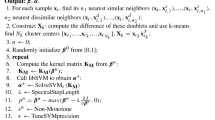Abstract
This paper presents a new classification method utilizing distance-based decision surface with nearest neighbor projection approach, called DDC. Kernel type of DDC has been extended to take into account the effective nonlinear structure of the data. DDC has some properties: (1) does not need conventional learning procedure (as k-NN algorithm), (2) does not need searching time to locate the k-nearest neighbors, and (3) does not need optimization process unlike some classification methods such as Support Vector Machine (SVM). In DDC, we compute the weighted average of distances to all the training samples. Unclassified sample will be classified as belonging to a class that has the minimum obtained distance. As a result, by such a rule we can derive a formula that can be used as the decision surface. DDC is tested on both synthetic and real-world data sets from the UCI repository, and the results were compared with k-NN, RBF Network, and SVM. The experimental results indicate DDC outperforms k-NN in the most experiments and the results are comparable to or better than SVM with some data sets.









Similar content being viewed by others
References
Laguia M, Castro JL (2008) Local distance-based classification. Knowl Based Syst 21:692–703
Bow ST (2002) Pattern recognition and image preprocessing, 2nd edn. Marcel Dekker, New York
Senda S, et al. (1995) A fast algorithm for the minimum distance classifier and its application to kanji character recognition. In: Proceedings of the third international conference on document analysis and recognition, vol 1, pp 283–286
Cover TM, Hart PE (1967) Nearest neighbor pattern classification. IEEE Trans Inf Theory 13:21–27
Aha DW et al (1991) Instance-based learning algorithms. Mach Lear 6:37–66
Duda RO et al (2001) Pattern classification. Wiley Interscience Publication, New York
Domeniconi C et al (2002) Locally adaptive metric nearest-neighbor classification. IEEE Trans Pattern Mach Intell 24:1281–1285
Vincent P, Bengio Y (2002) K-local hyperplane and convex distance nearest neighbor algorithms, vol 14. The MIT Press, Cambridge
Dasarathy BV (1991) Nearest neighbor (NN) norms: NN pattern classification techniques. IEEE Computer Society Press, Los Alamitos
Shakhnarovich G, et al. (2006) (eds) Nearest-neighbor methods in learning and vision: theory and practice. MIT press, Cambridge
Lam W et al (2002) Discovering useful concept prototypes for classification based on filtering and abstraction. IEEE Trans Pattern Mach Intell 24:1075–1090
Veenman CJ, Reinders MJT (2005) The nearest subclass classifier: a compromise between the nearest mean and nearest neighbor classifier. IEEE Trans Pattern Mach Intell 27:1417–1429
Olvera-Lo′pez JA et al (2010) A new fast prototype selection method based on clustering. Pattern Anal Appl 13(2):131–141
Herrero JR, Navarro JJ (2007) Exploiting computer resources for fast nearest neighbor classification. Pattern Anal Appl 10:265–275
Dudani SA (1976) The distance-weighted k-nearest-neighbor rule. IEEE Trans Syst Man Cybern 6:325–327
Zuo W et al (2008) On kernel difference-weighted k-nearest neighbor classification. Pattern Anal Appl 11:247–257
Bommanna KR et al (2010) Texture pattern analysis of kidney tissues for disorder identification and classification using dominant Gabor wavelet. Mach Vis Appl 21:287–300
Takada Y et al (1994) A geometric algorithm finding set of linear decision boundaries. IEEE Trans Signal Process 42:1887–1891
Cortes C, Vapnik V (1995) Support-vector network. Mach Learn 20:273–297
Kai Y et al (2002) Kernel nearest neighbor algorithm. Neural Process Letters 15:147–156
Luxburg UV, Bousquet O (2004) Distance-based classification with Lipschitz functions. J Mach Lear Res 5:669–695
Kosinov S, Pun T (2008) Distance-based discriminant analysis method and its applications. Pattern Anal Appl 11:227–246
Gaitanis N, et al. (1993) (eds) Pattern classification using a generalized hamming distance metric. International conference on neural networks
Pekalska E, Hassdonk B (2009) Kernel discriminant analysis for positive definite and indefinite kernels. IEEE Trans Pattern Mach Intell 31:1017–1031
Li X et al (2009) Kernel-based nonlinear dimensionality reduction for electrocardiogram recognition. Neural Comput Appl 18:1013–1020
Ruiz A, Lopez-de-Teruel PE (2001) Nonlinear kernel-based statistical pattern analysis. IEEE Trans Neural Netw 12:16–32
Downs T et al (2001) Exact simplification of support vector solutions. J Mach Learn 2:293–297
Nefedov A et al (2009) Experimental study of support vector machines based on linear and quadratic optimization criteria. DIMACS Technical Report, no. 2009–18, June 2009
Orr MJL (1996) Introduction to radial basis function networks. Center Cognitive Science University Edinburgh, UK, Edinburgh
Hettich S, et al. (1998) UCI Repository of machine learning databases. Available: http://www.ics.uci.edu/mlearn/MLRepository.html
Hastie T, Tibshirani R (1998) Classification by pairwise coupling. Ann Stat 26(2):451–471
Tax DMJ, Duin RPW (2005) Using two-class classifiers for multiclass classification. Pattern Recognition Group, Faculty of Applied Science, Delft University of Technology, Delft
Author information
Authors and Affiliations
Corresponding author
Rights and permissions
About this article
Cite this article
Hamidzadeh, J., Monsefi, R. & Sadoghi Yazdi, H. DDC: distance-based decision classifier. Neural Comput & Applic 21, 1697–1707 (2012). https://doi.org/10.1007/s00521-011-0762-8
Received:
Accepted:
Published:
Issue Date:
DOI: https://doi.org/10.1007/s00521-011-0762-8




